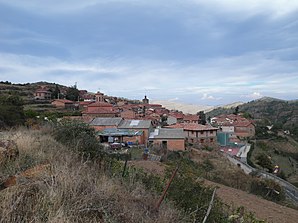Laguna de Cameros
| Laguna de Cameros municipality | ||
|---|---|---|
 Laguna de Cameros - town view
|
||
| coat of arms | Map of Spain | |
 Help on coat of arms |
|
|
| Basic data | ||
| Autonomous Community : |
|
|
| Province : | La Rioja | |
| Comarca : | Tierra de Cameros | |
| Coordinates | 42 ° 11 ′ N , 2 ° 33 ′ W | |
| Height : | 1050 msnm | |
| Area : | 41.6 km² | |
| Residents : | 104 (Jan. 1, 2019) | |
| Population density : | 2.5 inhabitants / km² | |
| Postal code : | 26135 | |
| Municipality number ( INE ): | 26082 | |
| administration | ||
| Website : | Laguna de Cameros | |
Laguna de Cameros is a place and a municipality ( municipio ) belonging to the populous Serranía Celtibérica with only 104 inhabitants (as of January 1, 2019) in the autonomous community of La Rioja in northern Spain .
Location and climate
The place Laguna de Cameros is located on the upper reaches of the Río Leza a good 46 km (driving distance) southwest of the provincial capital Logroño at an altitude of about 1050 m . Soria , the capital of the Old Castilian province bordering the Rioja to the south , is located about 57 km south. The climate is temperate to warm; Rain (approx. 625 mm / year) falls mainly in the winter months.
Population development
| year | 1857 | 1900 | 1950 | 2000 | 2018 |
| Residents | 563 | 563 | 392 | 176 | 116 |
As a result of the mechanization of agriculture , the abandonment of small farms and the resulting lower demand for labor, the number of inhabitants in the mountain town has declined significantly since the beginning of the 20th century ( rural exodus ).
economy
For centuries, the community was oriented towards agriculture for the purpose of self-sufficiency , with livestock farming (milk, cheese, meat) in the foreground. Today holiday apartments (casas rurales) are rented out mainly in the summer months .
history
Celtiberian , Roman , Visigoth and even Islamic-Moorish traces of settlement were not discovered in the municipality. The high-lying area served as summer pasture for sheep and goats for centuries . A military reconquest ( reconquista ) by the Christians did not take place, but the place was gradually settled as part of the Repoblación . Since around 1040 the area belonged to García Sánchez III. created manor (señorio) of the Tierra de Cameros . In the Middle Ages, the region was at times disputed between the kingdoms of Castile and Navarre . After the abolition of the manors in 1811, it belonged to the province of Soria and only came to the newly created province of Logroño in 1833, from which the region of La Rioja later emerged.
Attractions
- The single-aisled Iglesia de Nuestra Señora de la Asunción , built in the 16th century on the site of a previous medieval building made of stone and rubble (sillería y mampostería) , is dedicated to the Assumption of Mary . It has a bell tower (campanario) with a later added lantern and a lower transept . In the star-vaulted interior, the imposing altarpiece (retablo) behind the main altar is particularly worth seeing; In addition, the Romanesque font (pila bautismal) of the previous building has been preserved.
- The main square impresses with its size, which is unusual for a mountain village.
- There are several chapels (ermitas) in and around the town .
Web links
- Laguna de Cameros - Photos + Quick Facts (Spanish)
- Laguna de Cameros - short information (wikirioja, Spanish)
Individual evidence
- ↑ Cifras oficiales de población resultantes de la revisión del Padrón municipal a 1 de enero . Population statistics from the Instituto Nacional de Estadística (population update).
- ↑ Laguna de Cameros / Cabezón de Cameros - climate tables
- ↑ Laguna de Cameros - population development

